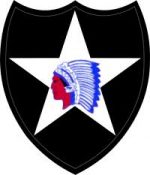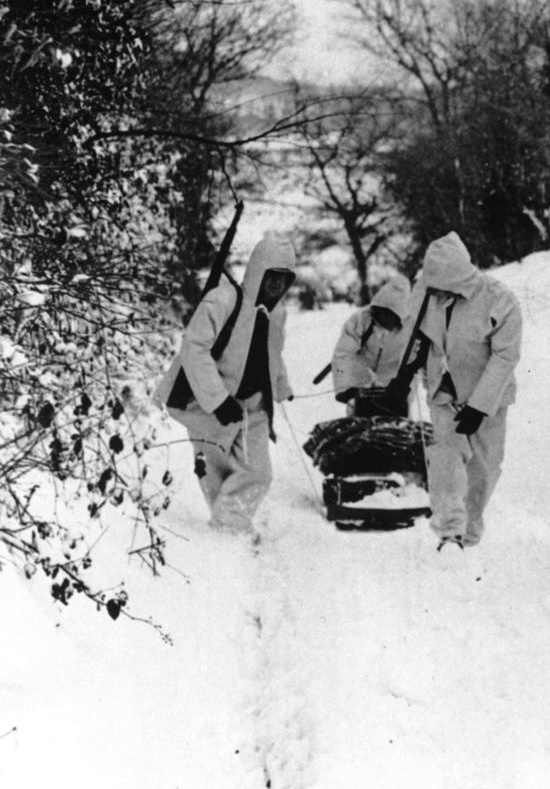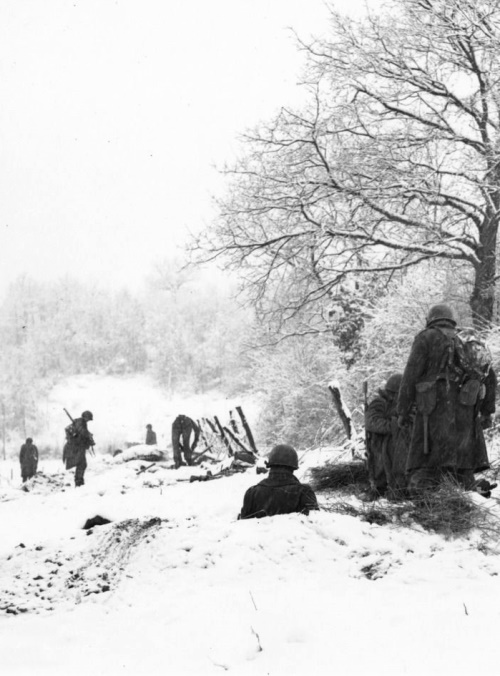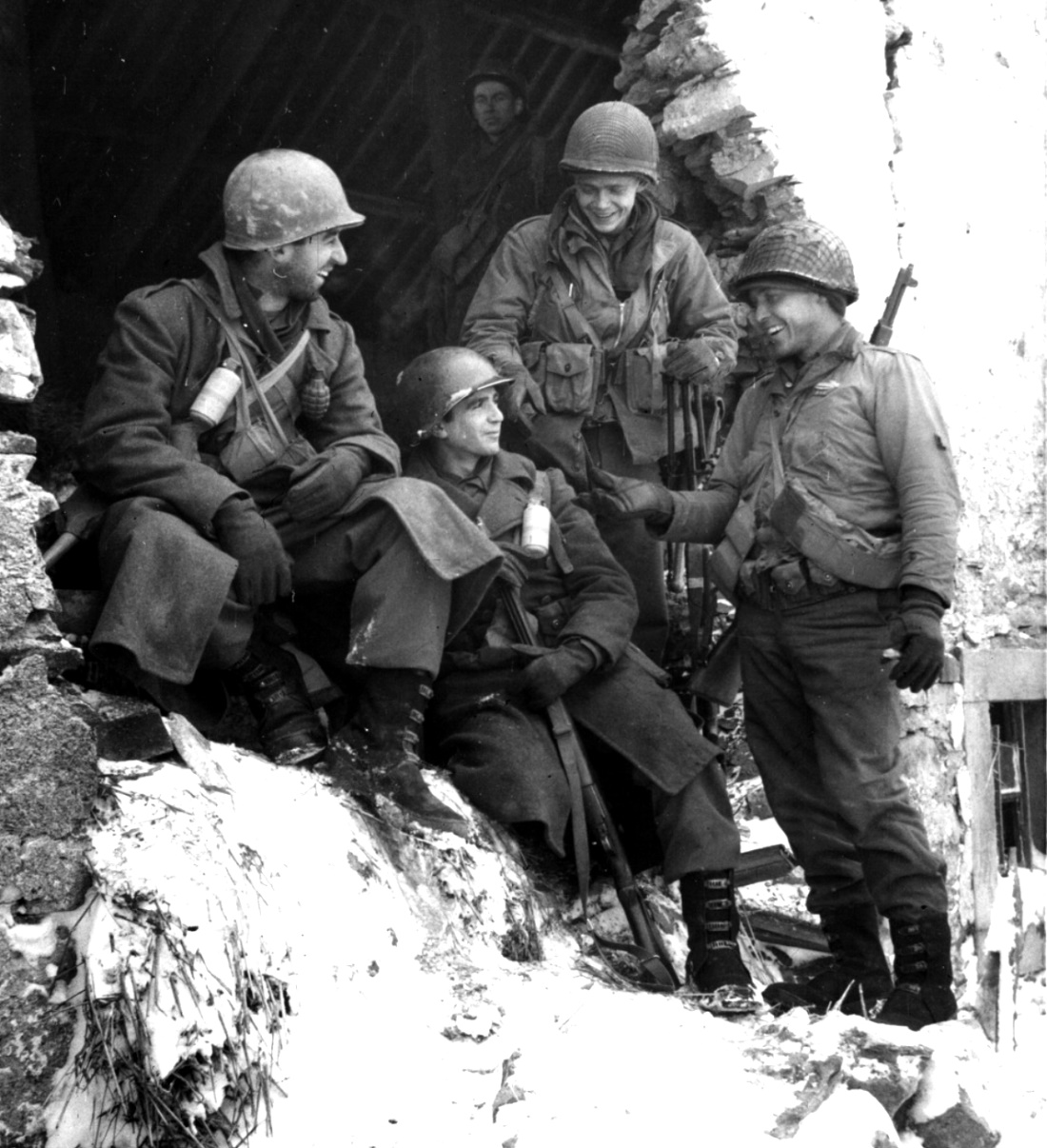
 According to the calculations of George 395 CO, the fortified position which was to be eliminated was not more than 500-600 yards to the immediate front on the high ground of Hill 621. Observation to the front from the company position was limited because of the hills, military crest, and the very heavy woods, which furnished excellent concealment. Sending a runner to the Battalion Hqs to inform them of the situation, positions of the company were consolidated, digging initiated, and preparations completed for the dispatching of a scouting patrol against the position to the front.
According to the calculations of George 395 CO, the fortified position which was to be eliminated was not more than 500-600 yards to the immediate front on the high ground of Hill 621. Observation to the front from the company position was limited because of the hills, military crest, and the very heavy woods, which furnished excellent concealment. Sending a runner to the Battalion Hqs to inform them of the situation, positions of the company were consolidated, digging initiated, and preparations completed for the dispatching of a scouting patrol against the position to the front.
Reconnaissance.
Lt Daniel P. Juraschek, who had been awarded the honor of leading the assault detachment as official recognition of his becoming a man on his 21st birthday on the following day (December 15), was designated as Recon Patrol Leader. In order to familiarize men of the assault detachment with the actual terrain surrounding the fortified position, the patrol was made up of men that would be included in the formation of the detachment. Also included in the patrol was the Artillery Field Observer who would attempt to conduct the necessary registrations to support the attack and the Platoon Leader of the heavy machine guns who would furnish close support to the detachment. Great care was exercised in selecting the general route to be followed by the patrol. Of a necessity, the detailed recon of the actual enemy position could not be planned until such time as the patrol was in a position to ascertain to what degree their movements would be restricted by retaliatory enemy activities. Following in the path of Pfc Felix X. Clark, the lead scout, the patrol cautiously moved out of the company area at 1430 to in part locate and pinpoint the fortification, determine the types and depth of passive defense measures, paying particular attention to the protective and tactical wire, locate and determine the number and sector of firing embrasures that would have to be considered in the assault of the position, determine the types and locations of enemy field fortifications supporting the concrete box, and locate and determine the type of any minefields.
By 1700, the patrol had worked its way back to the company position and although being subjected to sporadic enemy machine gun fire, the patrol had been remarkably successful in obtaining essential information on the fortification, particularly the position which had been pin-pointed about 400 yards over the military crest on the high ground of the hill that the company was disposed of on, that the fortification apparently was of the heavy reinforced concrete type, the position was completely wired in with both double apron protective and tactical barb wire entanglements, two firing embrasures would have to be silenced in the reduction of the position and finally, that the ground completely around the position was prepared with dug-in positions but apparently were not being manned during the time the position was under the observation of the patrol. It was apparent to the patrol that if these enemy positions were manned during the attack, they would do much to deny to the assault detachment the probably small sectors of dead space in the two firing embrasures of the concrete emplacement.
It was immediately decided that the remaining hours of daylight would be devoted to the completion of the attack plans for the reduction of the position. An H-Hour for the assault of the position was established for 1100 on the following day. Following detailed deliberations, taking into consideration the information brought back by the patrol, the organization of the assault detachment determined on was as follows, Assault Detachment Leader, Assistant Detachment Leader, 2 Demolition Men, each carrying 15 pounds of high explosives, 2 Wire-cutting Men, each carrying one section of Bangalore torpedo, 2 Flame-thrower Men, each carrying a flame-thrower, 2 Riflemen, each carrying 1 spare section of Bangalore torpedo, 2 Assistant Flame-thrower Men, one Platoon of Heavy Machine-Guns and One Section of Light Machine Guns. In addition to their individual arms and detachment equipment, each of the men had to carry a limited supply of hand grenades.
The Night Before the Assault.
A gap of approximately 100 yards still existed between Easy 395 and George 395 but was effectively blocked by a well-laid enemy minefield of Bouncing Bettie AP mines (S Mine), one of the Jerries favored AP Mine.
German S Mine (Springmine)(Bouncing Betty)
Functioning with a Pressure Fuze S Mi Z35, or/and Pull Fuze ZZ35, or/and Pull – Tension – Release Fuze ZUZZ35, and even an Electric Ignition Fuze ES Mi Z40. The working procedure is as follows, (1) Flash from fuze sets off a 4,5-sec pellet; (2) Pellet ignites black powder propelling charge; (3) Powder charge projects the inner case upward and ignites short delay pellet; (4) Short delay pellet sets off the detonator and main charge when mine is between 3 and 7 feet in the air and (5) the main charge scatter over 300 steel balls and metal fragments of the case up to 200 yards.
 Contact with the 2-ID on the left had never been gained and the extent of the existing gap was not known. All attempts to establish other than messenger contact with the Battalion Hqs had met with dismal failure. A friendly artillery concentration during the late afternoon of December 14 had been brought down on Easy 395 causing great damage. Information obtained later on from personnel of the Battalion Hqs indicated that this concentration had been called for by the Battalion Commander without being called for by either of the assault companies and despite the fact, the battalion could not have known the locations of the companies. The CO of Easy 395, Capt Richard E. Hornby, had been hit and the company was being led by the Executive Officer. No information was available as to the situation of the 1/395. Cold C rations once again constituted the evening meal. The resupply of water was accomplished by sending carrying parties to the rear with loads of canteens. By 1800, the company had dug in as well as the ground would permit, and solid rocks were encountered anywhere from one to two feet down.
Contact with the 2-ID on the left had never been gained and the extent of the existing gap was not known. All attempts to establish other than messenger contact with the Battalion Hqs had met with dismal failure. A friendly artillery concentration during the late afternoon of December 14 had been brought down on Easy 395 causing great damage. Information obtained later on from personnel of the Battalion Hqs indicated that this concentration had been called for by the Battalion Commander without being called for by either of the assault companies and despite the fact, the battalion could not have known the locations of the companies. The CO of Easy 395, Capt Richard E. Hornby, had been hit and the company was being led by the Executive Officer. No information was available as to the situation of the 1/395. Cold C rations once again constituted the evening meal. The resupply of water was accomplished by sending carrying parties to the rear with loads of canteens. By 1800, the company had dug in as well as the ground would permit, and solid rocks were encountered anywhere from one to two feet down.
At about 2300, the enemy artillery began to register on the position causing considerable damage because the Krauts were apparently firing into the tree tops and trunks thereby obtaining the same effect as time fire. Shortly before daylight, the enemy releases a surprise counterattack which was repulsed with a minimum of effort. The enemy had not displayed much aggressiveness during the action, withdrawing quickly after being engaged. No casualties were sustained. It appeared that the reverse-slope defense that the company had assumed had the enemy confused as to the unit’s exact location and intent.
Day of Assault.
Daylight seemed to ease the slightly tensed nerves of the night. Information relative to Easy 395 being shelled by friendly artillery, unfortunately, had passed on throughout the company. This information coupled with the absence of battalion control or influence had created an unhealthy mental state in the men. Once again C rations were consumed. Communications with Battalion Hqs were still limited to foot messengers. The Battalion Hqs, it was learned from returning messengers, was located roughly 2500 yards to the right rear of the two assault companies. It was further learned that Fox 395 had reverted to battalion control and had been placed in a position to protect the Battalion CP. The A&P Platoon of the Battalion Hqs Co was continuously employed in logging in the Battalion CP. On checking the company positions, the CO found Pfc Clark who had acted as a scout on the recon patrol of the preceding day, lying on the ground outside of his foxhole. Further investigation revealed that Clark had been hit by artillery fire during the night. However, he requested that he be permitted to remain with the company to complete his assignment as one of the Demolitions Men of the assault detachment before being evacuated. His request was granted. Particular mention is made of this incident given the part Pfc Clark played in the ultimate success of the assault detachment.
Plans for the assault in part included (a) that the assault detachment would move forward to reduce the position at 1100; (b) that the Company Command Group would move up with the assault detachment to a point from which the entire operation could be under direct observation; (c) that the support platoon of the company, the 2nd Platoon, would move up behind the assault detachment taking up a position securing the left flank of the zone in addition to being in a position to furnish any additional support required by the attacking elements; (d) the remainder of the company was to remain on the alert under the direct control of the Company Executive Officer in its present position, prepared to move out on orders; (e) radio contact in addition to visual contact would be maintained between the assault detachment Leader and the Company CP.
The Assault.
At approximately 1100, the assault detachment led by Lt Juraschek cautiously inched its way forward through the heavy woods surrounding the enemy position reaching their previously selected assault positions under cover of the woods. On a signal from the Detachment Leader, the artillery Forward Observer called for the previously registered concentration on the enemy position to force the defenders to ‘button up’ their fighting embrasures while the two sections of heavy machine guns, one section to each embrasure, effected their move into previously selected firing positions. The concentration was on the target, effectively neutralizing the fire of the fortification. Immediately, retaliatory enemy artillery fire commenced coming in. However, because of the mask created by the hill, the fortification was on, the shells passed a few yards overhead and burst 100-200 yards to the rear of the assault detachment. The supporting artillery fire of the assault unit was lifted and the detachment waited tensely for the heavy machine guns to take up their mission of keeping the firing embrasures of the pillbox buttoned up while the detachment breached the wire and moved in.
Machine gun fire broke out from the ‘pillbox’; a hasty check with the Detachment Commander revealed that the attached heavy machine guns had not had sufficient time to go into position. The Artillery Forward Observer was instructed to repeat the concentration. This time, the machine guns were successful in reaching their positions and immediately took up rapid-fire as soon as the artillery support lifted. No enemy movement had been observed in the open trenches surrounding the fortification and no direct fire was being received from other than the firing embrasures of the fortification. Pfc Spencer was now snaking himself forward pushing two assembled sections of Bangalore torpedoes across the snow in front of him. Finally reaching the double apron barb wire he slid the charge under the wire, pulled the fuse lighter, and quickly dove for cover. Both sections of heavy machine guns were forced to fire at their sustained rates of fire in order to force the defenders, to keep their firing embrasures closed. The section of light machine guns had gotten into position effectively covering the left flank, and also being in a position to support an emergency. One, then two minutes went by, and then it was realized that the Bangalore torpedo was a dud.
Once again Pfc Spencer, this time on his own initiative, wormed his way forward under cover of the machine guns. Quickly refusing the charge Spencer again ignited the fuse and once more made a hasty withdrawal. This time the protective wire was breached with a roar and the Assault Detachment poured through the gap. At this time small arms fire broke out against the left flank of the company but was quickly silenced by the 2nd Platoon which had moved up into position covering that flank. The Assault Detachment had now reached their assigned positions close to the enemy emplacement working themselves into the slight dead spaces 15 to 20 yards from the corner of the fortification between the two firing embrasures. Both of the flame-thrower men had worked their way as far forward as possible and were in excellent positions to cover the Demolitions Charge men in the all-important task of placing their charges in the embrasures. The machine guns continued to do the most effective job of keeping down the fire from the ‘pillbox’ itself. Both flame-thrower men were working frantically to get their equipment into operation to blind the defenders of the emplacement.
Precious seconds passed and still neither of the flame throwers was in operation. Pfc Felix X. Clark realizing that the situation was critical and without the important protective cover of the flame throwers, entirely on his own initiative, rushed forward into the hail of machine gun fire ricocheting off the concrete emplacement, placed his charge against the right embrasure, and quickly dove for cover. Seconds later there was an ear-splitting roar, the position had been breached by the blowing in of the embrasure. Quickly, enemy defenders came pouring out of the rear of the emplacement hands in the air. Hastily rounding up the enemy survivors two of the detachment members started them moving to the rear while the remainder of the detachment finished cleaning out the fortification. Pfc Clark in assisting in the removal of the prisoners from the emplacement area stepped into an unnoticed AP minefield and was instantly killed. The detachment immediately placed the necessary security to cover the reorganization of the position. The reduction of the position had been effected by approximately 1230. Enemy communications (wire) were still in operation to the fortification and German voices could be heard trying wildly to establish contact with the pillbox. We decided to sever these communications and five minutes later the Germans began an intense artillery shelling directly onto the ‘pillbox’ itself.
This continued for some time but finally lifted. The security that the detachment had placed outside of the concrete emplacement was subjected to a terrific shelling but could not be withdrawn into the ‘box’ for fear of being counter-attacked. The shells bursting on the box itself did not affect the detachment. The remainder of the company was now moved forward to positions supporting the fortified position which it had been discovered enjoyed one firing embrasure to the rear which covered a limited sector of the ground in that direction and made a formidable contribution to the strength of the company position. A messenger was dispatched to the Battalion HQs informing them of the situation. An inspection of the fortified installation showed that the satchel charge placed by Pfc Clark had torn the steel embrasure door off of the guides thereby effectively breaching the position. The installation had five large rooms separated by steel doors, the walls were from three to four feet in thickness. The steel rear door could be reached only after a zig-zag course through concrete corridors. The two embrasures which had faced the assault detachment effectively covered the entire sector through which the assault had been made. The two 105-MM howitzer concentrations which had been fired on the position in support of the assault detachment had succeeded in knocking out a small number of pieces of concrete about half as large as the average hand.
The assaulting force had sustained 2 killed. The enemy had sustained 2 killed and 13 captured. The Battalion HQs had not as yet established contact with G-395 but on being advised by the company of its success sent forward a man from the S-2 section to sketch the fortification. G-395 had by this time been out of contact with Battalion HQs since approximately 0800 the preceding day. During that time no information had been furnished or any control exercised over the Company by Battalion HQs. To sum up the results of this action, the assault detachment of G-395 did succeed in reducing, in a commendable fashion, the fortified position in the zone of action. The importance of the action as contributing to the ultimate success of the company or of the Battalion was never to be known as the enemy initiated its counter-offensive in the Ardennes on the following day, Dec 16, bringing to a grinding halt the December offensive of the V Corps.

























